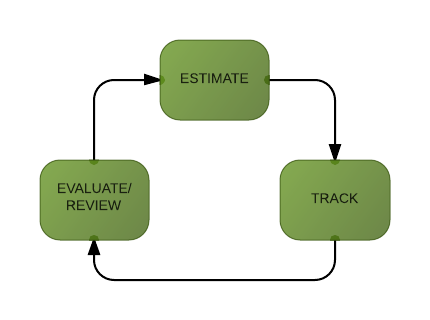Project Management
It’s useful to think of a project as having a beginning (kickoff meeting) as well as an end (“project close”).
A project is not a department or and ongoing category of tasks, as in all tasks regarding, e.g. “accounting” 1 .
For our purposes, project management, specifically internal project management, which is not concerned with the integration of or the communication with clients, is mainly concerned with coordinating the efforts of your team to accomplish specific outcomes “in budget”.
Project Management Is Simple
To illustrate the basic idea of project management, let’s say a group of people decides to build a house.
- They have to agree on what the house will look like and its features, how many rooms it will have, where the kitchen is going to be, and so on. ➞ defining the specific goal (deliverable)
- Once you know what you want, you can create a list of to-dos. ➞ backlog
- Next, you need to sort that list by priority. Tiling the roof moves further down the list than building the base. ➞ prioritizing
- The group also decides on who is going to do what. ➞ assignments
- The amount of time (or resources) needed to complete each task on the list needs to be estimated. ➞ time management
- Once the actual building process starts, someone has to coordinate, control and adjust to keep the project on track ➞ project manager
- When the status of the project reaches completion, you close and celebrate. ➞ closing
- The group discusses the learnings from the closed project ➞ post mortem
Prioritizing, Planning, Coordinating
As laid out in the analogy above, the list of things that need to happen to complete the project needs to be sorted. Dependencies between tasks have to be addressed and coordinated.
Time Management
Time is the most valuable resource we have. It can’t be managed unfortunately. You can only manage yourself and your team to make the best use of the time you have. (Read about the Opportunity cost of time on our blog).
Everything I write about time management can also be transferred to managing any other resource. We could therefore simply view it as one area / application of resource management.
To improve time and project management with your team, you need to cycle through three stage. Your estimates will get better with experience (tracking and reviewing).
- Estimating how much time a task will take
- Tracking how much time it actually takes
- Evaluating/Reviewing and creating a feedback loop to improve future estimates

Responsibility and Accountability
Each project has one person responsible for getting it done. All other members of the project report to this person.
Each task or item on the to-do list has one person responsible for getting it done.
See also our Task Manager guide.
There are cases and circumstances in which you can use projects as if they were departements of your company (and vice versa). Just don’t confuse the two or think the terms are interchangable. ↩